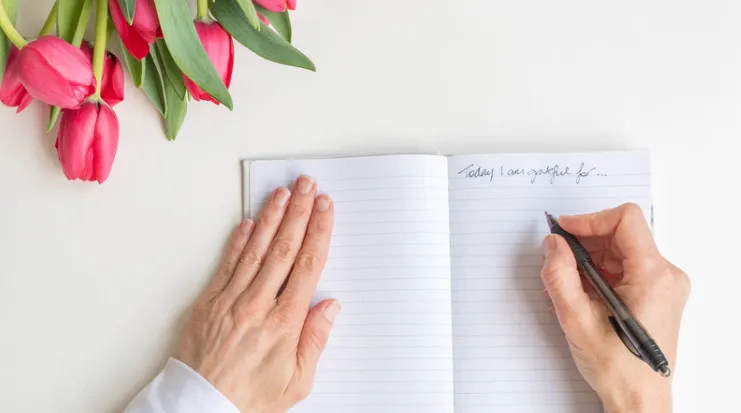Welcome to Your Path to Balance - Mindset and Self-Care Blog
A space dedicated to providing you with valuable insights, practical tips and inspiring stories that can help you navigate your self-care and mindset journey. Dive into topics around emotional resilience, positive mindset, healthy habits, work-life balance, stress management, relaxation techniques, mental well being and physical health. Learn how using powerful mindset tools such as NLP, Hypnosis and TLT can support you in achieving your self-care goals.

Transform Your Life with Gratitude Journaling - A Simple Daily Practice
Do you ever find yourself dwelling on negative thoughts, feeling overwhelmed, or struggling to appreciate the positives in your life? Imagine if a simple daily habit could shift your focus and bring more happiness and positivity into your everyday routine. Intrigued? Many people struggle with negative thinking patterns that can impact their mental health and overall well-being. But did you know that a simple exercise called gratitude journaling can help change your mindset?
When I first started gratitude journaling, I was sceptical. I felt like my days were just filled with stress and finding time to reflect on the positive seemed impossible. But I decided to give it a try. After a few weeks of writing down three things I was grateful for each day, I noticed a significant shift. I felt more optimistic, my stress levels decreased and I started appreciating the small joys in life.
The act of gratitude journaling has now definitely become a powerful tool in my daily routine, helping me to cultivate a more positive and fulfilling life. So read on to find out more about it and how it can help you too.
What is Gratitude Journaling?
Gratitude journaling is the act of writing down things you are thankful for each day. This could be anything from a good cup of coffee in the morning to a supportive friend or family member. By taking a few minutes each day to reflect on the positive aspects of your life, you can begin to rewire your brain to focus on the good instead of the bad.
How Does Gratitude Journaling Work?
Gratitude journaling works by shifting your mindset from one of lack to one of abundance. When we focus on the things we don't have or the problems we face, we can easily slip into negative thought patterns that can impact our mental health. By intentionally focusing on the good things in our lives, we can begin to retrain our brains to look for the positive.
Research has shown that practicing gratitude can lead to a wide range of benefits, including improved mental health, better sleep and reduced stress and anxiety. One study even found that participants who wrote in a gratitude journal for just three weeks reported increased levels of happiness and life satisfaction.
The Science Behind Gratitude
Gratitude journaling isn't just a feel-good exercise; there's a substantial body of scientific research supporting its benefits. Studies have shown that gratitude can activate the brain's reward systems, increasing the production of dopamine and serotonin - chemicals that are crucial for our mood and overall sense of well-being. This means that regularly practicing gratitude can help create a more positive mental and emotional state over time.
Moreover, gratitude has been linked to improved physical health. People who practice gratitude consistently report fewer aches and pains, better immune function and even lower blood pressure. This holistic benefit shows that gratitude journaling can be a key component of both mental and physical health.
How to Start Gratitude Journaling
Starting a gratitude journal is simple. All you need is a notebook or a piece of paper and a pen. Set aside a few minutes each day to reflect on the positive things in your life and write them down. Some people prefer to do this first thing in the morning or before bed, while others find it helpful to take a few minutes during a break in their day.
Here are some tips to help you get started:
Choose a Time and Place: Find a quiet time and place where you can reflect without interruptions. Consistency is key, so try to make it a daily habit.
Start Small: Begin by writing down three things you're grateful for each day. These don't have to be grand or significant; even small moments of joy or comfort can have a big impact.
Be Specific: Instead of writing "I'm grateful for my family," try "I'm grateful for my sister's call today and it made me feel loved and supported."
Reflect on the Why: Take a moment to reflect on why you're grateful for each item. This deepens the emotional impact of the exercise and helps reinforce positive feelings.
Mix It Up: Don't be afraid to write about different aspects of your life. Over time, you might notice that you start appreciating things you previously took for granted.
Alternative Gratitude Practices
While gratitude journaling is a fantastic practice, here are a few alternative gratitude exercises that might suit your preferences:
Gratitude Jar: Write down things you are grateful for on small slips of paper and put them in a jar. At the end of the month or year, read through them to reflect on the positive moments. There is also a great digital app called Gratitude Jar that allows you to add digital entries daily. With a click of a button it also gives you the ability to reflect back on previous gratitude notes any time you want to.
Gratitude Meditation: Spend a few minutes in quiet reflection, mentally noting the things you're grateful for.
Thank You Notes: Write thank you notes or emails to people who have made a difference in your life. This not only helps you focus on positive interactions but also spreads positivity.
Overcoming Common Challenges
Like any new habit, gratitude journaling can come with its own set of challenges. Here are a few common obstacles and how to overcome them:
Finding the Time: If you're struggling to find time for journaling, try integrating it into an existing routine. For example, you could jot down your thoughts while having your morning coffee or just before going to bed.
Staying Consistent: Set reminders on your phone or put your journal somewhere you'll see it every day. Consistency is crucial for seeing long-term benefits.
Running Out of Ideas: If you feel like you're repeating yourself, challenge yourself to notice new things each day. Look for beauty in the mundane and everyday experiences.
Summary
Gratitude journaling helps shift focus from negative to positive thoughts.
It's scientifically proven to enhance mental and physical health.
Starting is simple: write down three things you're grateful for each day.
Consistency and specificity are key to maximising the benefits.
Alternative practices like gratitude jars and thank you notes can also be effective.
In a world that often emphasises what we lack or what we need to improve, gratitude journaling offers a refreshing reminder of the abundance and goodness already present. So why not give it a try? Start your gratitude journal today and begin your journey toward a happier, more fulfilling life.
Gratitude journaling is just one way you can practice self-care - if you want to know more about self-care, get my Free Ultimate Self-Care Guide
Copyright © 2024 Coni Moloney - All rights reserved.
© 2024 All Rights Reserved, Coni Moloney

